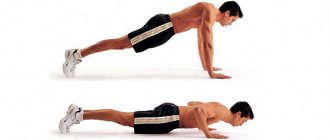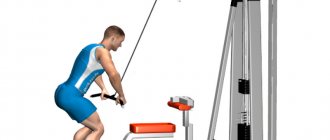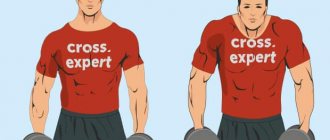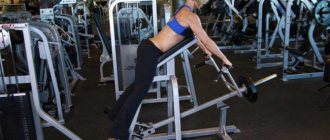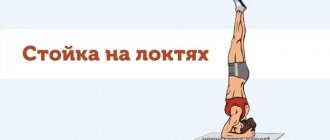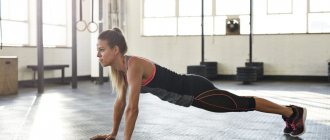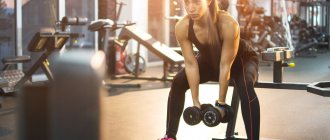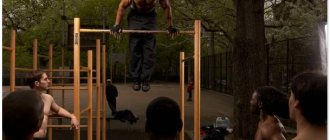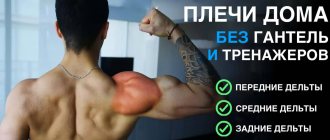The back is truly important in training, but few bodybuilders give it the attention it requires. Effectively pumping up muscles in this area is the goal of every successful athlete!
Only an experienced athlete can pump up a wide back, because this muscle group is very difficult to work out, so for an excellent result you will need all your skill and a lot of patience. If you have set yourself the goal of acquiring a truly pumped-up wide back, exercises need to be selected carefully and wisely.
No compromises, just work and more work!
The back includes some of the largest muscles in the upper body from the lumbar region to the trapezius muscles (more on the anatomy of the back muscles in the guide to how to build a stronger back). It's involved in virtually every movement we make, from stabilizing the core during the bench press to supporting the barbell during the squat.
You see how important it is to train your back, are you ready to train? If you are already in the gym and ready to start, we recommend 2 programs from our training videos.
Further in the article you will find several more program options.
The first training option is about how to pump up your back. In this video you will learn how to pump up your back, what exercises to do to pump up your latissimus dorsi muscles.
- Lying latissimus dorsi stretch
- Chest row on the upper block, 3x8
- Pull-ups with deviation, 3x8
- Reverse grip lat pull-down, 3x8
- Wide-grip lat pulldown, 3x8
In the next video you will learn the second training option for the back muscles.
Feel free to ask your questions about how to build back muscles in the comments. Our goal is to help you achieve better results in your training.
- Lower back stretch with lunge and twist, 2x5
- Standing mid-back stretch (with body rotation), 2x5
- Rows to the waist on the simulator in support, 3x8
- Pullover on block, 3x8
- Bent-over barbell row, 3x8
- Shrugs with dumbbells, 3x8
Not everyone can boast of a wide, pumped-up back, and this is another argument in favor of the fact that its development deserves special attention. Many athletes do countless sets of chest training, but forget to put equal effort into building a broad back.
Probably one of the reasons is that it is difficult to see your back when standing in front of a mirror. Why train what you can't see, right?
There are so many men in the gym with big pecs, biceps and quads, but few who can show off a wide back, neck or triceps pumped up to the size of powerful horseshoes. Their rounded shoulders project forward because the pectoral muscles push the deltoids forward, giving them a concave appearance.
This means that the back was not trained enough and/or correctly to pull the shoulders back and create a proportionate appearance. The key to this is balance. You must create such a balance of mass and strength to achieve an impressive, muscular, strong and harmonious body. Balance will improve your entire body and help you avoid looking like a “jock” from the outside.
How to create an outstanding back? The presented exercises and workouts are specially selected in such a way as to get the most out of every trip to the gym and build up a broad back for you. Always pay attention to your technique and do not use too much weight for your safety.
Exercises for back width
Wide and narrow grip pull-ups
For the wide grip variation, use a grip wider than shoulder width. Begin the exercise by slightly bending your elbows and pulling them toward your chest, focusing on squeezing your shoulder blades together behind you. Arch your back and contract your muscles, then return to the starting position with your elbows slightly bent again.
This will develop sought-after width and range in the upper back muscles.
Weighted pull-ups
In the narrow grip version, either grab the bar with a parallel grip narrower than shoulder width, approximately six 15 cm between your palms. Pull up as if with a wide grip, and lower down until your hands lock out. This exercise aims to strengthen the lower back muscles and create thickening near the lumbar region, which will help create a visually wider back.
If you have difficulty doing this exercise, there is one good trick. Pick a total number of reps, such as 40, and try to reach that number no matter how many sets you need. You can do 10 reps on the first set, 8 on the second, and 7 on the third. Continue until you have completed 40 repetitions. When you can do 3-4 sets of 10 or 15 reps each, increase your total reps to 50 or more.
Consider other pull-up variations as well.
Rocky Pull-Ups
Grasp the bar with a straight wide grip, bending at the waist. As you exhale, pull your torso up until the bar touches your sternum. Lower yourself and repeat the exercise, only now the bar should go behind your neck.
Rocky Pull-Ups
One arm pull-ups
Drape a rolled towel over the bar. With one hand, grab the horizontal bar with your palm facing you, and with the other hand, grab the towel. Tilt your body back about 30 degrees. As you exhale, pull yourself up until your chest touches the bar. Pause and lower yourself slowly. Switch hands.
One arm pull-ups
Wide grip pull-ups
Grab the bar with a wide grip, palms facing forward. As you exhale, pull your body up until your neck touches the bar. As you inhale, slowly lower yourself to the starting position.
Wide grip pull-ups
Barbell row
These machines help build mass for overall muscle density, working toward our goal of a toned, broad back. To lift the barbell, hold the bar shoulder-width apart. Bend over, keeping your back in line with your hips and parallel to the floor, transfer your weight to your stomach and contract your muscles. Slowly lower the bar and repeat.
Bent-over barbell row
If you experience discomfort when lifting the barbell, attach a wide handle to the cable of the lower pulley and pull it instead of the barbell, holding it with a shoulder-width (or slightly wider) grip.
T-bar row
When lifting a T-bar, follow the same rules, but be careful not to drop the weight or arch your back. Keep your back straight and let your back muscles do the work, not your lumbar region.
T-bar row
If you lack mass in your upper back, try doing barbell curls with a wider grip and pull the weight toward your lower chest. In this case, you will have to reduce the weight in order to perform this wide back exercise correctly without getting injured.
Belt row on the block
To really gain mass in your lower back muscles (if you're interested in a wider back, of course), try one of these exercises.
To perform the pulley lift exercise, take your starting position: sit and tilt your upper body forward, knees slightly bent. At the same time, pull the handle and straighten your body perpendicular to the floor. Squeeze your shoulder blades together and pull the handle towards your abdominal muscles. Return to starting position and repeat.
Belt row on the block
Belt row on the machine
An undeniable advantage of rowing in the simulator is that you can work each side separately. Use the principles above and make sure to contract the muscles as you return to the starting position.
Belt row on the machine
Parallel and wide grip rows
For a wide-grip row, grab the bar with an overhand grip and lower it to your upper chest. Return the bar to the starting position, controlling the weight with your shoulders and keeping your elbows slightly bent. In terms of pumping quality, this exercise perfectly replaces pull-ups, creating the desired volume and width of the back.
Wide-grip lat pulldown
Pulldown of the upper block (pullover)
Nothing works the teres muscle better than parallel grip rows.
Pulldown of the upper block (pullover)
Grab the bar with a grip slightly wider than shoulder-width and bend your elbows slightly. Lower the bar to the middle of your chest and contract your muscles. Return to the starting position, feeling the weight force your back muscles to work upward and outward.
When performing any downward pull, try to return the shoulder girdle to its original position. Drop your shoulders back slightly and arch your chest forward. This will allow you to fully engage your back muscles.
Dynamic stretching of the back muscles
To stretch your back muscles, stand in front of a back row machine (or other machine with a cable running overhead). Take the bar with a shoulder-width grip and hold it at approximately eye level, tensing your back muscles. This is the starting position.
Dynamic stretching of the back muscles
With straight arms, lower the weight to your hips and contract your back muscles. Return the bar to the starting position and repeat. Variations of this exercise can be used as a warm-up before working the entire back. Three quick sets of moderate reps will do the trick.
Deadlift
The ancestor of all back exercises is the deadlift. A healthy, strong, wide back loves this exercise.
Deadlifts are essential for overall core strength from head to toe, but deadlifts are especially beneficial for your back. Place the weight on the bar on the ground and take a shoulder-width grip with your knees bent, keeping your back straight.
Overhand grip deadlift
Lift the weight off the ground using your legs first, and then begin to straighten your back until you stand completely straight. Return the bar to the ground, performing the movements in reverse order.
If you have trouble deadlifting from the floor, try partial deadlifts. It is distinguished from the usual deadlift by its starting position: here the barbell begins to move not from the floor, but from the level of the athlete’s knees, for example, in a power rack or from a bench. Set the bar at this level and then simply follow normal lifting principles. This will relieve your back a little if you are tall or want to engage your leg muscles in the exercise.
For beginners, we recommend the option with a trap bar
Deadlift with trap bar
Rule 3: Correct technique
During training, the correct execution of the movement is very important. After all, exercises for the latissimus muscles are basic in nature, that is, a large number of muscle groups work.
Very often (especially for beginners) they are performed using the strength of the biceps and trapezius, while the latissimus muscles work only slightly, without receiving the proper load.
To eliminate this common problem, you need to perform the exercise by concentrating on squeezing and stretching your lats.
Another effective method is constant monitoring of the convergence of the shoulder blades. When lifting weights, you should try to contract them as much as possible, and the lats will automatically contract as well.
But the biceps should be excluded from the movement.
Concentrate on simply holding the weight with your hands like hooks, and using your back to perform the entire movement.
A popular mistake even among experienced gym goers is heavy cheating in almost all lat exercises.
Of course, the back muscles are large and strong. To train them, you can use significant weights, but only if you follow the correct movement technique.
In this case, the entire load will be aimed at pumping the target muscle.
Upper back training program
Pull-ups
- a total of 30-40 repetitions
- Body Part: Lat Equipment: Bodyweight
Bent-over barbell row
- 3 sets of 8-12 reps
- Body Part: Press Equipment: Barbell
Pull-down of the upper block behind the head
- 3 sets of 8-12 reps
- Body part: Lat Equipment: Block
Quick box squats using expanders
- 3 sets of 8-12 reps
- Body part: Quadriceps Equipment: Barbell
Add to Calendar * Add to My Workouts * Print Workout
* — The service is in beta testing
How to warm up?
Warm-up should be carried out in several stages.
Stage #1: Stretch the Neck
As part of the first stage of the warm-up, the teenager will have to stretch the muscles of his neck. To do this, he needs to lower his chin to his chest. Stand in this position for at least ten and no more than fifteen seconds. Then, the teenager needs to throw his head back so that it is located at the back. He needs to stay in this position for ten to fifteen seconds. Each of the above movements must be repeated without fail. At least two or three times.
Next, the teenager needs to place the inside of the hand on his head. Above. With this hand, the teenager needs to lower his head to the left. As close to the shoulder as possible. Similarly, the muscle must be stretched for thirty seconds. After completing the exercise, the teenager needs to change sides. Tilt your head with your hand to the right. It is recommended to do this exercise several times.
As part of the third warm-up exercise, the teenager needs to fix his chin in the “flat” position. Turn your head to the left. And turn it in the direction in which it is directed. It's like stretching a muscle a little. You need to spend at least ten seconds on each side. The number of repetitions is three or four times.
Stage #2: Stretch your shoulders
At the next stage, the teenager will have to stretch his shoulders. Thus preparing them for training.
As part of the first exercise, the teenager should place his arms along his body. Then, he should begin to clench his fists. And unclench them. As quickly and intensely as possible. You need to do this exercise three to four times for each hand.
After this, the teenager needs to start rotating his fists. This should be done for three to five seconds. For each side.
Then, the teenager must do arm raises without fail. And rotate your elbows. This must be done for three to five seconds. For each side.
After the teenager has completed these steps, his shoulders will be sufficiently stretched. And he will be able to move on to doing exercises. Without fear of pulling muscles. Or that they won't be warmed up.
Training program for muscle growth
Smith Machine Bent Over Row
- 3 sets of 6-8 reps
- Body part: Middle back Equipment: Exercise
Deadlift
- 5 sets of 4-8 reps
- Body part: Quadriceps Equipment: Barbell
Wide grip pull-ups
- 3 sets of 8-12 reps
- Body Part: Lat Equipment: Bodyweight
Pull-down of the upper block behind the head
- 3 sets of 8-12 reps
- Body part: Lat Equipment: Block
Add to Calendar * Add to My Workouts * Print Workout
* — The service is in beta testing
Lower back training program
Pull-down of the upper block behind the head
- 3 sets of 8-12 reps
- Body part: Lat Equipment: Block
Downward pull of the upper block
- 3 sets of 8-12 reps
- Body part: Lat Equipment: Block
Smith Machine Bent Over Row
- 3 sets of 8-12 reps
- Body part: Middle back Equipment: Exercise
Lying barbell row
- 3 sets of 8-12 reps
- Body part: Middle back Equipment: Barbell
Add to Calendar * Add to My Workouts * Print Workout
* — The service is in beta testing
"Basket"
Athletes who want to figure out how to widen their back should periodically perform the “Basket” exercise. The training allows you to effectively load the latissimus and rhomboid muscles. The technique is particularly simple. Lie on your stomach on the floor. Bend your back and grab your feet with your palms. Try to stay in this position for several minutes. In order to tense the maximum number of small muscles, alternate the usual holding of the pose with rocking the body back and forth.
Training program for total mass and muscle growth
Pull-ups
- a total of 30-40 repetitions
- Body Part: Lat Equipment: Bodyweight
Bent-over barbell row
- 3 sets of 8-12 reps
- Body Part: Press Equipment: Barbell
Wide grip pull-ups
- 3 sets of 8-12 reps
- Body Part: Lat Equipment: Bodyweight
Deadlift
- 3 sets of 6-10 reps
- Body part: Quadriceps Equipment: Barbell
If you have trouble deadlifting from the floor, try a partial deadlift. Place the weight on the bar on a bench just below your knee and then simply follow normal lifting principles. This will relieve your back a little if you are tall or want to engage your leg muscles in the exercise.
Add to Calendar * Add to My Workouts * Print Workout
* — The service is in beta testing
A wide and pumped back is the dream of every man, especially if nature did not endow him with it in the first place. But it is precisely due to a wide back that a bodybuilder looks strong and impressive, and the daily worries of life become significantly and literally easier.
Rule 2: Balance sets, reps, weight and rest
An important factor in the rapid muscle growth of the latissimus is the correct selection of training load.
Depending on your fitness level, these indicators can vary greatly:
- Beginners
The pumping frequency for beginners is every 3-4 days or 2 times a week. The number of exercises per workout is 2-3, with two sets of each movement. Repetitions within 10-15.
- Average level
May be limited to training frequency once a week. The program usually contains 3-4 exercises, with 3 approaches each. Rep range: 8-12.
- Advanced
For advanced exercisers, the lats are also worked out once every 7 days. But a larger number of exercises are used - 4-6. In this case, repetitions are reduced to 6-10 times. Approaches in each movement from 3 to 5.
For beginners, light and medium weights are used; for intermediate and advanced levels, heavier weights are chosen.
Rest pauses between approaches are the same - 1.5-2 minutes.
Training program for pumping up a wide back
Pullover with barbell
- 3 sets of 8-12 reps
- Body part: Lat Equipment: Barbell
Pull-ups
- a total of 30-40 repetitions
- Body Part: Lat Equipment: Bodyweight
Pullover with barbell
- 3 sets of 8-12 reps
- Body part: Lat Equipment: Barbell
Bent-over barbell row
- 3 sets of 8-12 reps
- Body Part: Press Equipment: Barbell
Lying barbell row
- 3 sets of 8-12 reps
- Body part: Middle back Equipment: Barbell
Add to Calendar * Add to My Workouts * Print Workout
* — The service is in beta testing
To avoid going to the gym empty-handed, pay attention to concentration and technique. Engage only the necessary muscles to build a really wide back!
Always pay attention to your technique and do not use too much weight for your safety. Be sure to warm up before your workout and stretch after!
Sports nutrition will help speed up the process of gaining muscle mass - protein, creatine, gainer, arginine, BCAA, amino acids. These supplements are specially designed for athletes and fitness-active people of different fitness levels. Such drugs are completely safe, and their effectiveness has already been proven.
Reasons to start exercising today
The first impression of a person is formed by his appearance. Slouched, hunched figures repel people and do not motivate them to get to know each other further. Women subconsciously prefer men whose broad figure they can hide behind; next to them they feel protected.
Do you want to be successful with the opposite sex? Save the poetry and your interesting, deep personality for later. Start to amaze with your beautiful curves and strong body constitution.
Often the fair sex undeservedly ignores these areas, placing more emphasis on the legs, buttocks and abs. But this is a completely wrong decision, because it is a strong core that contributes to the correct implementation of power loads on other muscle groups, and is also an excellent strength for the spine and all internal organs.
They are also repelled by the fear of losing their femininity, because a wide back is the calling card of men. But these fears are unfounded, because specially designed trainings for women help the formation of a seductive V-shaped silhouette without overload.
By the way, especially for the fair sex, I recommend reading an article about the main issues in fitness that concern girls.
